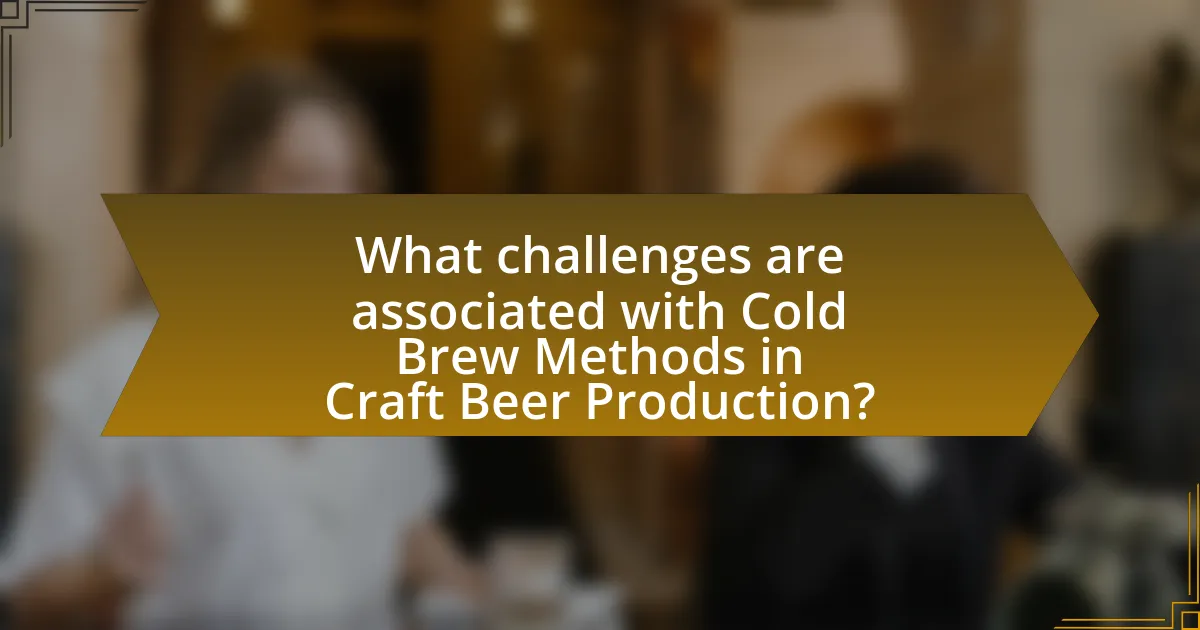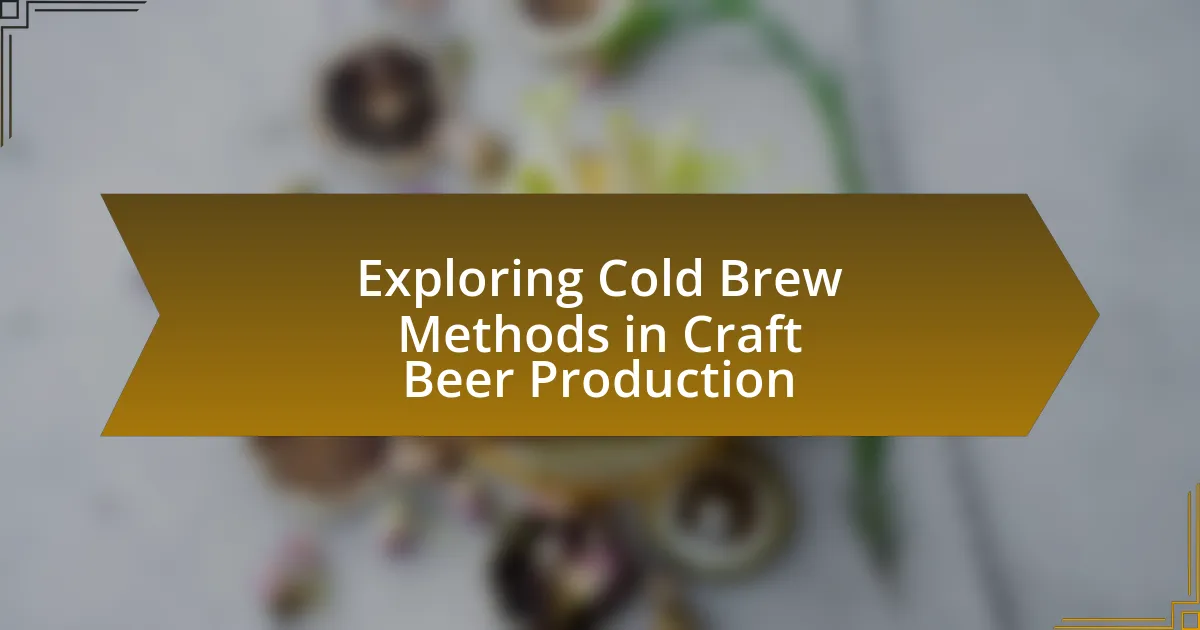Cold brew methods in craft beer production involve steeping coarsely ground coffee in cold water for 12 to 24 hours, allowing brewers to create unique flavor profiles while minimizing bitterness. This article explores the differences between cold brew and traditional brewing techniques, the specific processes involved, and the key ingredients used, including the influence of coffee bean types and water quality. It also addresses the benefits and challenges of cold brew methods, innovative trends in flavor experimentation, and best practices for successful production. Additionally, the article examines how consumer preferences and technological advancements may shape the future of cold brew in the craft beer industry.

What are Cold Brew Methods in Craft Beer Production?
Cold brew methods in craft beer production involve steeping coarsely ground coffee in cold water for an extended period, typically 12 to 24 hours, to extract flavors without the bitterness associated with hot brewing. This technique allows brewers to create unique flavor profiles by integrating coffee into various beer styles, such as stouts or porters, enhancing the overall sensory experience. The cold brew process is favored for its ability to produce a smoother, less acidic beverage, which can complement the malt and hop characteristics of the beer.
How do cold brew methods differ from traditional brewing techniques?
Cold brew methods differ from traditional brewing techniques primarily in the temperature and time used for extraction. Cold brew involves steeping coarsely ground coffee in cold or room temperature water for an extended period, typically 12 to 24 hours, which results in a smoother, less acidic flavor profile. In contrast, traditional brewing methods, such as drip or espresso, utilize hot water to extract flavors quickly, usually within a few minutes, leading to a more pronounced acidity and bitterness. This fundamental difference in temperature and extraction time significantly influences the taste and characteristics of the final beverage.
What specific processes are involved in cold brewing for beer?
Cold brewing for beer involves steeping coarsely ground coffee in cold water for an extended period, typically 12 to 24 hours. This process extracts flavors and compounds from the coffee without the bitterness associated with hot brewing methods. The cold brew coffee is then filtered to remove the grounds, resulting in a concentrated coffee liquid. This concentrate can be blended with beer during fermentation or added to finished beer for flavor enhancement. The cold brewing method is known for producing a smoother, less acidic taste profile, which is preferred in certain craft beer styles.
How does temperature affect the brewing process in cold brew methods?
Temperature significantly influences the extraction of flavors and compounds during the cold brew process. In cold brew methods, lower temperatures (typically around 4-12 degrees Celsius) slow down the extraction rate, resulting in a smoother, less acidic beverage compared to traditional brewing methods that use hot water. Research indicates that at higher temperatures, such as 20-25 degrees Celsius, extraction occurs more rapidly, leading to a more pronounced bitterness and acidity due to the solubility of certain compounds, including caffeine and oils. Therefore, controlling temperature is crucial for achieving the desired flavor profile in cold brew.
What are the key ingredients used in cold brew craft beer?
The key ingredients used in cold brew craft beer are coarsely ground coffee, water, malted grains, hops, and yeast. Coarsely ground coffee is steeped in cold water for an extended period, typically 12 to 24 hours, which extracts flavors without the bitterness associated with hot brewing methods. Water serves as the primary solvent, while malted grains provide sugars necessary for fermentation. Hops contribute bitterness and aroma, balancing the sweetness of the malt. Finally, yeast is essential for fermentation, converting sugars into alcohol and carbonation. This combination of ingredients results in a unique flavor profile characteristic of cold brew craft beer.
How do different types of coffee beans influence the flavor profile?
Different types of coffee beans significantly influence the flavor profile due to their unique characteristics. Arabica beans, known for their sweetness and acidity, often present flavors ranging from fruity to floral, while Robusta beans, which are stronger and more bitter, typically impart earthy and nutty notes. The growing conditions, such as altitude and climate, also affect the beans’ chemical composition, further diversifying the flavor profiles. For instance, beans grown at higher altitudes tend to develop more complex flavors due to slower maturation, which enhances acidity and sweetness. This variation in flavor profiles is crucial for applications like cold brew in craft beer production, where the choice of coffee bean can dramatically alter the final taste of the beverage.
What role does water quality play in cold brew beer production?
Water quality is crucial in cold brew beer production as it directly influences the flavor, aroma, and overall quality of the final product. The mineral content, pH level, and purity of the water can affect the extraction of coffee compounds during the brewing process. For instance, water with high mineral content can enhance the extraction of desirable flavors, while impurities can introduce off-flavors or undesirable characteristics. Studies have shown that specific water profiles can optimize the brewing process, leading to a more balanced and flavorful cold brew.
What are the benefits of using cold brew methods in craft beer?
The benefits of using cold brew methods in craft beer include enhanced flavor extraction, reduced bitterness, and improved aroma. Cold brew techniques allow for a smoother and more balanced taste profile, as the lower temperatures extract flavors without drawing out excessive tannins and oils that can lead to bitterness. Additionally, cold brewing can preserve volatile aromatic compounds, resulting in a more fragrant beer. Studies have shown that cold extraction methods can yield a more complex flavor profile, appealing to craft beer enthusiasts seeking unique and refined tastes.
How does cold brewing impact the aroma and taste of the beer?
Cold brewing significantly alters the aroma and taste of beer by producing a smoother, less acidic flavor profile. This method extracts flavors at lower temperatures, which minimizes the extraction of bitter compounds and enhances the sweetness and malt characteristics. Research indicates that cold brewing can lead to a more pronounced aroma of floral and fruity notes, as the volatile compounds responsible for these aromas are preserved better in cold conditions. Additionally, a study published in the Journal of the American Society of Brewing Chemists found that cold-brewed beers often exhibit a more balanced flavor, with a reduction in harshness compared to traditional brewing methods.
What advantages does cold brew offer in terms of shelf life and stability?
Cold brew offers significant advantages in terms of shelf life and stability due to its lower acidity and the absence of heat in its brewing process. The cold brewing method extracts flavors over an extended period, resulting in a smoother beverage that is less prone to oxidation and spoilage. Research indicates that cold brew can maintain its quality for up to two weeks when stored properly, compared to traditional hot brewed coffee, which typically has a shelf life of only a few days. This extended shelf life is attributed to the reduced presence of volatile compounds that can degrade over time, making cold brew a more stable option for craft beer production.

What challenges are associated with Cold Brew Methods in Craft Beer Production?
Cold brew methods in craft beer production face several challenges, including extraction efficiency, flavor consistency, and equipment requirements. The extraction efficiency can be lower compared to traditional brewing methods, leading to a need for longer steeping times or higher coffee-to-water ratios, which can complicate the brewing process. Flavor consistency is another challenge, as variations in coffee bean quality and brewing conditions can result in significant differences in taste, making it difficult for brewers to replicate successful batches. Additionally, specialized equipment may be necessary for cold brewing, which can increase production costs and require additional training for staff. These challenges highlight the complexities involved in integrating cold brew methods into craft beer production.
What are the common pitfalls in cold brew beer production?
Common pitfalls in cold brew beer production include improper coffee-to-water ratios, inadequate steeping time, and poor filtration methods. Using incorrect ratios can lead to overly bitter or weak flavors, as the balance between coffee and water is crucial for achieving the desired taste profile. Insufficient steeping time may result in under-extraction, failing to capture the full range of flavors from the coffee. Additionally, ineffective filtration can leave sediment in the final product, negatively impacting clarity and mouthfeel. These factors collectively influence the quality and overall experience of the cold brew beer.
How can brewers avoid over-extraction during the brewing process?
Brewers can avoid over-extraction during the brewing process by carefully controlling variables such as brew time, water temperature, and grind size. Specifically, reducing the brew time prevents excessive extraction of bitter compounds, while maintaining a lower water temperature helps to extract desirable flavors without pulling unwanted astringency. Additionally, using a coarser grind size limits the surface area exposed to water, which further mitigates the risk of over-extraction. Research indicates that optimal brewing conditions can significantly enhance flavor profiles while minimizing undesirable characteristics, thus supporting the effectiveness of these methods in achieving balanced cold brew coffee in craft beer production.
What issues can arise from improper storage of cold brew beer?
Improper storage of cold brew beer can lead to spoilage, off-flavors, and loss of carbonation. When cold brew beer is not stored at the correct temperature, typically between 35°F to 45°F, it can promote the growth of bacteria and yeast, resulting in sour or unpleasant tastes. Additionally, exposure to light can cause skunking, which negatively affects the beer’s flavor profile. Research indicates that beer stored improperly can lose its intended aroma and taste within weeks, emphasizing the importance of maintaining optimal storage conditions for quality preservation.
How can brewers troubleshoot cold brew production issues?
Brewers can troubleshoot cold brew production issues by systematically evaluating the brewing process, including grind size, water temperature, steeping time, and coffee-to-water ratio. For instance, if the cold brew is overly bitter, adjusting the grind size to a coarser setting can help, as finer grinds can lead to over-extraction. Additionally, ensuring the water temperature remains between 60°F to 70°F during steeping can prevent undesirable flavors. The steeping time should typically range from 12 to 24 hours; if the brew is too weak, extending the steeping time may enhance flavor extraction. Lastly, a common ratio of 1:4 coffee to water can be adjusted based on taste preferences, with a stronger brew requiring a higher coffee ratio. These adjustments are supported by industry practices that emphasize the importance of these variables in achieving optimal cold brew quality.
What steps can be taken to adjust flavor profiles effectively?
To adjust flavor profiles effectively in craft beer production, brewers can manipulate ingredients, brewing techniques, and fermentation processes. By varying the types and amounts of malt, hops, and adjuncts, brewers can create distinct flavor notes. For instance, using roasted malts can impart chocolate or coffee flavors, while different hop varieties can introduce citrus or floral notes. Additionally, adjusting the brewing temperature and time can influence the extraction of flavors, with higher temperatures often leading to more intense flavors. Fermentation temperature and yeast strain selection also play crucial roles; specific yeast strains can enhance fruity or spicy characteristics. These methods are supported by industry practices, as evidenced by the diverse flavor profiles found in award-winning craft beers, which often result from intentional adjustments in these areas.
How can temperature control be optimized during brewing?
Temperature control can be optimized during brewing by utilizing precise temperature monitoring equipment and implementing a controlled heating or cooling system. Accurate thermometers and temperature probes allow brewers to maintain the desired temperature range throughout the brewing process, which is crucial for extracting the right flavors and aromas. Research indicates that maintaining specific temperature profiles can enhance the extraction of desirable compounds while minimizing unwanted flavors, as seen in studies on cold brew coffee where temperatures between 60°F to 70°F yield smoother profiles. Additionally, using insulated brewing vessels can help maintain stable temperatures, reducing fluctuations that can negatively impact the final product.

What innovative trends are emerging in Cold Brew Craft Beer Production?
Innovative trends in Cold Brew Craft Beer Production include the use of nitrogen infusion for enhanced creaminess and mouthfeel, as well as the incorporation of unique flavor profiles through the addition of spices, fruits, and other botanicals. Nitrogen infusion has gained popularity because it creates a smoother texture and a visually appealing cascading effect in the beer, which appeals to consumers. Additionally, breweries are experimenting with cold brew coffee blends, allowing for a fusion of coffee and beer flavors that cater to the growing demand for hybrid beverages. This trend is supported by the increasing consumer interest in craft beverages, with the craft beer market projected to grow significantly, indicating a shift towards more innovative and diverse offerings in the industry.
How are brewers experimenting with flavors in cold brew beer?
Brewers are experimenting with flavors in cold brew beer by incorporating various ingredients such as fruits, spices, and herbs to create unique taste profiles. For instance, some brewers add citrus fruits like oranges or lemons to enhance brightness, while others use spices like cinnamon or vanilla to introduce warmth and complexity. Additionally, the use of different coffee bean varieties and roasting levels allows brewers to manipulate the base flavor, resulting in a diverse range of cold brew beers. This trend is supported by the growing consumer interest in innovative and artisanal beverages, as evidenced by the increase in craft beer sales, which reached approximately $23.1 billion in 2020, highlighting the market’s demand for unique flavor experiences.
What unique ingredients are being incorporated into cold brew beers?
Unique ingredients being incorporated into cold brew beers include various spices, fruits, and alternative sweeteners. Craft brewers are experimenting with ingredients like vanilla beans, cacao nibs, and even chili peppers to enhance flavor profiles. For instance, the use of cold brew coffee in stouts and porters has become popular, where the coffee’s natural bitterness complements the beer’s maltiness. Additionally, fruits such as orange peel and berries are added to create refreshing and aromatic variations. These innovative ingredients not only diversify the taste but also appeal to a broader audience seeking unique craft beer experiences.
How are collaborations between coffee roasters and breweries evolving?
Collaborations between coffee roasters and breweries are evolving towards more innovative and diverse product offerings. This evolution is characterized by the integration of cold brew coffee into various beer styles, enhancing flavor profiles and creating unique beverages. For instance, breweries are increasingly experimenting with coffee-infused stouts and porters, where cold brew coffee is added during fermentation to achieve a balanced taste. Additionally, the trend of limited-edition releases and seasonal collaborations has gained traction, with brands like Founders Brewing Co. and Intelligentsia Coffee showcasing successful partnerships that highlight the synergy between coffee and beer. This shift reflects a growing consumer interest in craft beverages that combine distinct flavors and artisanal techniques.
What are the future prospects for cold brew methods in craft beer?
The future prospects for cold brew methods in craft beer are promising, as they offer unique flavor profiles and appeal to a growing consumer demand for innovative beverages. Cold brew techniques can enhance the extraction of flavors from coffee and other ingredients, allowing brewers to create distinctive beers that stand out in a competitive market. The increasing popularity of cold brew coffee has paved the way for similar methods in beer production, with craft breweries experimenting with various combinations of coffee and beer styles. Additionally, market research indicates that the craft beer segment is expanding, with consumers seeking novel experiences, which positions cold brew methods as a viable trend for future growth.
How might consumer preferences shape the development of cold brew beers?
Consumer preferences significantly influence the development of cold brew beers by driving breweries to innovate flavors, brewing techniques, and marketing strategies. As consumers increasingly seek unique and refreshing beverage options, breweries respond by experimenting with diverse ingredients, such as different coffee beans and flavor infusions, to cater to these tastes. For instance, a 2021 market research report indicated that the cold brew coffee market is projected to grow at a CAGR of 25% from 2021 to 2028, reflecting a rising consumer demand for cold brew products. This trend encourages breweries to adopt cold brew methods in their beer production, ensuring they align with consumer expectations for quality and novelty.
What technological advancements could enhance cold brew production?
Technological advancements that could enhance cold brew production include improved extraction methods, temperature control systems, and automation technologies. Enhanced extraction methods, such as ultrasonic extraction, can increase flavor yield and reduce brewing time, leading to a more efficient process. Temperature control systems allow for precise management of brewing conditions, ensuring optimal flavor profiles and consistency. Automation technologies streamline the brewing process, reducing labor costs and minimizing human error. These advancements collectively contribute to higher quality cold brew with greater efficiency, as evidenced by studies showing that optimized extraction techniques can increase flavor compounds by up to 30%.
What best practices should brewers follow for successful cold brew production?
Brewers should follow several best practices for successful cold brew production, including selecting high-quality coffee beans, using the correct coffee-to-water ratio, and ensuring proper steeping time and temperature. High-quality coffee beans enhance flavor and aroma, while a common ratio is 1:4 or 1:5 coffee to water for optimal extraction. Steeping should occur at room temperature or in the refrigerator for 12 to 24 hours to achieve a balanced taste. Additionally, filtering the brew through a fine mesh or coffee filter prevents sediment and ensures a smooth final product. These practices are supported by industry standards that emphasize the importance of ingredient quality and precise brewing techniques for achieving the desired flavor profile in cold brew coffee.
